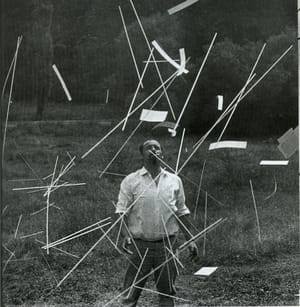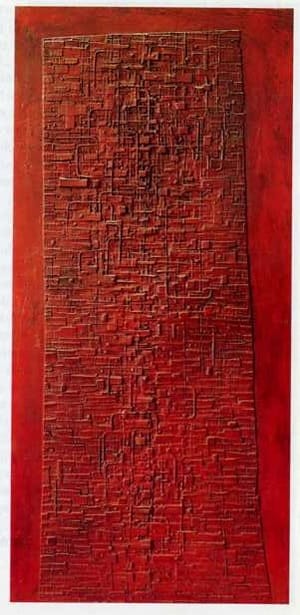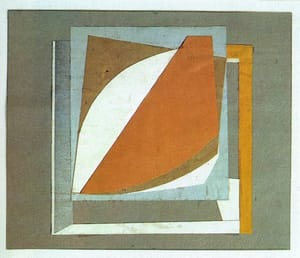- First Name
- Hugo
- Surname
- Demartini
- Born
- 1931
- Birth place
- Prague
- Died
- 2010
- CSU Library
- ↳ Find in the catalogue
About artist
Hugo Demartini was one of the most important representatives of constructivist tendencies in Czech art of the sixties and seventies. However, his work resonates beyond this, beginning with Art Informel and ending with monumental sculptural installations. Demartini received a classical education in sculpture. He began his studies in stonemasonry at the well known Otakar Velínský workshop, after which he studied at the Prague Academy with Professor Lauda. In 1956, after completing his military service (part of which he spent at the Military Art Studio, including two months in Brno with Vincenc Makovský), he completed a cycle of plaster bas-reliefs on a Christian theme, the first of his works displaying a strong, original creative intelligence. Geometric compositions of collages made from coloured paper survive from the end of the fifties. At this time he was also creating traditional busts, though at the turn of the fifties and sixties he moved definitively over to the position of the creative avant-garde of that time and joined the strong current of informal abstraction. His most important contribution is a series of low reliefs created by imprinting small elements in clay and then casting them in plaster, to which he then adds bright red paint. We can interpret these pieces as absurd schemes or as models of the kind of labyrinth we encounter in the work of Sekal. At the same time there is clearly a movement in the direction of a geometric dictionary. This becomes fully apparent in 1964, when the issue of Art Informel was pretty much burned out. A basic surface usually in the shape of a square is divided by a regular grid. Relief elements are inserted in individual cells. At the beginning these are variously cut truncated pyramids, subsequently they are exclusively spheres. The first reliefs are made of coloured plaster, but when chrome plates appear he works only with them. The chrome spheres become the symbol of his creative output. Chrome corresponds more to the impersonal character of the artistic intention which lay behind constructivism, while at the same time expanding possibilities. On the one hand it is a reference to the world of technology, to the “second nature” as it was dubbed at that time, and therefore to contemporary visuality. More important is the element of mirroring, both of the viewer, which establishes a new relationship between viewer and work, as well as of the individual elements themselves, which enter into a mutual optical interaction. Demartini cuts the spheres in various ways, sometimes cutting convex and concave semi-spheres in serial works. At the same time he makes the spheres larger and begins to experiment with various types of boxes in which to insert them. However, the most fundamental experiment involves drawing the spheres out from the purely geometrical background of the underlay and gallery environment and taking them into the landscape. Photography captures the composition of several perfectly burnished chrome spheres on deserted paths or fields.
In the same year, 1968, Demartini created a second series of experimental works. These events, entitled Demonstrations in Space, involved throwing items (cylinders, skewers, confetti, etc.) in the air and capturing their random configurations both during freefall and on the ground where they fell. The output of both events is documentation in the medium of photography, though both still relate to the world in question and the space structured by it. Even though they belong to the sphere of conceptual art by virtue of their thematicisation of chance, it is clear that they were created by a sculptor. Demartini did not continue down this path of radical dematerialisation, though it was one of the most up-to-date and interesting strands of Czech art of the time. Over the next few years he developed the previous problematic of minimalist reliefs.
Somewhat later, in 1973, Demartini began a series of objects entitled Out of Bounds, which links directly up to the second of the experiments referred to. These objects involved the careful attachment of items (usually cuttings from models of public events, which at the time represented his means of support) thrown over a hardboard base (most often in the form of a square 110cm x 110cm in size) on this base. The theme of chance links them with the shift taking place at that time in the work of Zdeněk Sýkora, who had at this time moved over to his stochastically generated lines. The works again take the form of a relief, only occasionally intended for horizontal positioning. This corresponds to the process of their creation, a fact which anticipates future works.
In 1978 one of the reliefs of this cycle – this time under a name that would be often used later, Model – is supplemented with a careful illusion of ruins and decay. This was to become an important element of Demartini’s sculptures, which Josef Hlaváček succinctly described as “geometric formations in various states of disintegration”. The artist first constructs planking, which he covers with plaster. He destroys the resulting shapes with a hammer and immediately fixes the shards – similarly to the way that previously sticks had dropped onto the base – through smearing them with plaster. Certain models, especially those from around the turn of the seventies and eighties with their motifs of hanging drapery, give the impression of stage designs for theatre of the absurd, which incidentally was one of the main inspirational sources of Demartini’s generation. The author then follows these themes of architecturally structured space and disintegration in the final period of his life, which he spent in a rural studio in Sumrakov, not far from Telč.
- Author of the annotation
- Marcel Fišer
- Published
- 2010
CV
Studies
1949-1953 Academy of Fine Arts, atelier of Jan Lauda
1948-1949 Higher School for Sculptors, Prostejov
Employment:
1989-1996 head of the sculpture stdio at the Academy of Fine Arts, Prague
Exhibitions
- Solo exhibitions
-
2008
Akce a proměna geometrické skladby, Topičův salon, Praha
2007
Klub Galerie V kapli, Bruntál
2006
Hugo Demartini a klasická tradice, Galerie Benedikta Rejta, Louny
Bombírované kresby 1960-62, Minigalerie 6.15, Zlín
2005
Přípravné modely, Galerie Benedikta Rejta, Louny
Objekty šedesátých let, Galerie Montanelli, Praha
Objekty, Státní hrad a zámek Jindřichův Hradec
2004
Koláže, kresby, objekty, Galerie výtvarného umění v Chebu, Kabinet grafiky a kresby
2003
Galerie Pecka, Praha
2002
Galéria Komart, Bratislava
2000
Retrospektiva, Oblastní galerie v Liberci
Akce a proměna geometrické skladby, Státní galerie výtvarného umění v Chebu
1999
HD 1965 - 1975, Galerie Václava Špály, Praha
Tvorba z let 1965 - 1975, Galerie Aspekt, Brno
1995
Galerie MK, Rožnov pod Radhoštěm
1994
Tvorba z let 1958 - 1978, Dům umění, Ostrava
Dům umění města Brna
1992
Výběr z díla z let 1980 až 1991, Mánes, Praha
1991
Dílo 1964 - 1974, Dům U Kamenného zvonu, GHMP, Praha
1988
Hugo Demartini: Objekty, Jiří Sozanský: Obrazy, Lidový dům, Praha
1986
Hugo Demartini, Pavel Nešleha. Projekty, VS Atrium, Praha
1971
Plastiky 1964 - 1970, Galerie Benedikta Rejta, Louny
1966-1967 Akce a proměna geometrické skladby, Galerie na Karlově náměstí, Praha
1963
Krajský projektový ústav, Praha
- Group exhibitions not included in ARTLIST.
-
2010
New Sensitivity, National Art Museum of China, Beijing
2005
Privátní pohled (Sbírka Josefa Chloupka), Dům pánů z Kunštátu, Brno
Prostor a čas, GMU v Roudnici nad Labem
2004
Umění je abstrakce: Česká vizuální kultura 60. let, Staatliches Museum für angewandte Kunst, Mnichov
Ejhle světlo, Jízdárna Pražského hradu, Praha
Šedesátá / The sixties, Ze sbírky Galerie Zlatá husa v Praze, Dům umění města Brna, Brno
Blízká vzdálenost/ Közeli távolság/ Proximate Distance, Szent István Király Múzeum, Székesfehérvár
2003
Ejhle světlo, Moravská galerie v Brně
Umění je abstrakce: Česká vizuální kultura 60. let, Jízdárna Pražského hradu, Praha
Svět jako struktura, Struktura jako obraz, Zámek Klenová, Klenová
2001
Barevná socha, Severočeská galerie výtvarného umění v Litoměřicích
2000
100 + 1 uměleckých děl z dvacátého století, Dům U černé Matky Boží, ČMVU Praha
Současná minulost: Česká postmoderní moderna 1960-2000, AJG Hluboká nad Vltavou
Jubilejní výstava Akademie výtvarných umění 1800-2000, Valdštejnská jízdárna, Praha
1999
Akce, slovo, pohyb, prostor - experimenty v umění šedesátých let, Městská knihovna, GHMP, Praha
Umění zrychleného času. Česká výtvarná scéna 1958 - 1968, ČMVU Praha
1996
I. nový zlínský salon, Zlín
V prostoru 20. století, České umění ze sbírky Galerie hlavního města Prahy, Městská knihovna
Umění zastaveného času, ČMVU Praha
1994
Nová citlivost, SGVU Litoměřice, OGV Jihlava, Dům umění, Opava, Moravská galerie v Brně
Ohniska znovuzrození, Městská knihovna, GHMP Praha
1993 Záznam nejrozmanitějších faktorů… České malířství 2. poloviny 20. století ze sbírek státních galerií, Jízdárna Pražského hradu, Praha
Příběhy bez konce, Princip série v českém výtvarném umění, MG Brno, NG Praha
Poesie racionality. Konstruktivní tendence v českém výtvarném umění šedesátých let, Valdštejnská jízdárna, Praha
1992
Minisalon, Galerie Nová síň, Praha
Situace 92, Mánes, Praha
1991
Český informel: Průkopníci abstrakce z let 1957 - 1964, Praha
Tradition und Avantgarde in Prag, Kunsthalle Dominikanerkirche, Osnabrück
Šedá cihla 78/1991, Galerie U Bílého jednorožce v Klatovech, Galerie Klatovy / Klenová
1990
Pocta umělců Jindřichovi Chalupeckému, Městská knihovna, Praha
Zaostalí, Galerie Nová síň, Praha
Nová skupina. Městská knihovna, Praha
Zaostalí, Lidový dům, Praha
Konstruktivní tendence šedesátých let, Severočeská galerie výtvarného umění v Litoměřicích, SG v Praze
1988
Forum 1988, Holešovická tržnice, Praha
1983
Das Prinzip Hoffnung. Aspekte der Utopie in der Kunst und Kultur des 20. Jahrhunderts, Museum Bochum
Prostor, architektura, výtvarné umění, Výstaviště Černá Louka, Ostrava
1981
Netvořice ´81, Dům Bedřicha Dlouhého, Netvořice (Benešov)
1979
Bedřich Dlouhý: Kresby a obrazy, Hugo Demartini: Plastiky, Zdeněk Ziegler: Plakáty,Bechyňská brána, Tábor
1972
50 Jahre Konstruktivismus in Europa, Galerie Gmurzynska, Kolín nad Rýnem
Konstruktive Kunst aus der Tschechoslowakei, Galerie im Erker, Sankt Gallen
1970
Konfrontace I, Galerie Nova, Praha
Klub konkrétistů, Dům pánů z Kunštátu, Brno
Demartini, Kratina, Kubíček, Malich, Sýkora, Alšova síň v Klubu skladatelů, Praha
Tschechische Skulptur des 20. Jahrhunderts, von Myslbek bis zur Gegenwart,Schloß Charlottenburg, Berlín
1969
15 Arte contemporanea in Cecoslovacccia, Galleria Nazionalle d´Arte Moderna, San Marino
Konstruktivismens Ars, Sonja Henies Og Niels Onstads Stiftelser, Oslo
Biennale Nürnberg 1969. Konstruktive Kunst. Elemente und Prinzipien, Kunsthalle Nürnberg
1968
Contemporary Czechoslovakian Art, Jacques Baruch Gallery, Chicago
5 Künstler aus Prag, Galerie Dr. H. Becher, Medebach, Galerie Club Paderborn
Klub konkrétistů a hosté, Oblastní galerie Vysočiny v Jihlavě
Nová citlivost. Křižovatka a hosté. Dům umění města Brna, Dům kultury pracujících Ústí nad Labem, Galerie umění Karlovy Vary, Mánes Praha
Alternative attuali III. Rassegna internazionale d´arte contemporanea. Aspetti della nuova scultura in Europa, Castello Spagnolo, L´Aquila
Sculpture tchècoslovaque de Myslbek à nos jours, Musée Rodin, Paříž
1967
Konstruktive Tendenzen aus der Tschechoslowakei, Studio Galerie der Johann Wolfgang Goethe Universität, Frankfurt am Main
Moderne Kunst aus Prag, Caroline-Mathilde-Räume im Celler Schloß, Celle, Wilhelm-Morgner-Haus, Soest, Schleswig-Holsteinischer Kunstverein, Kiel
Konstruktivní tendence, Galerie Benedikta Rejta, Louny
VI. Biennale d’Arte Repubblica di San Marino. Nuove tecniche d’immagine, Palazzo dei Congressi, San Marino
Jeden okruh volby, Okresní muzeum Písek
1966
Tvůrčí skupina Umělecká beseda, Mánes, Praha
Konstruktivní tendence, GVU Roudnice nad Labem
Nové cesty. Přehlídka současné avantgardy, Dům umění Gottwaldov
Jarní výstava, Mánes, Praha
Konstruktivní tendence, OGV Jihlava
Tschechoslowakische Kunst der Gegenwart, Akademie der Künste, Berlín
Aktuální tendence českého umění. Obrazy, sochy, grafika, Praha
Výstava mladých, Dům pánů z Kunštátu, Brno
1965
Výstava mladých, Výstavní síň ÚLUV , Praha
1964
Umělecká beseda, Mánes, Praha
Socha 1964, Liberec
1958
Umění mladých výtvarníků Československa 1958, Dům umění města Brna
1956
Výstava Grekovova studia Sovětské armády a československých výtvarných umělců, Praha
1955
II. krajské středisko Umělecká beseda, Praha
1953
2. přehlídka československého výtvarného umění 1951 - 1953, Jízdárna Pražského hradu, Praha
1958
Umění mladých výtvarníků Československa 1958. Jízdárna Pražského hradu, Praha
- Collections
-
Alšova jihočeská galerie v Hluboké nad Vltavou
Centre Georges Pompidou, Paříž
Galerie Benedikta Rejta, Louny
Galerie hlavního města Prahy
Galerie moderního umění v Hradci Králové
Galerie Středočeského kraje, Kutná Hora
Galerie umění Karlovy Vary
Moravská galerie v Brně
Museum Bochum
Museum Folkwang, Essen
Muzeum umění Olomouc
Národní galerie v Praze
Oblastní galerie v Liberci
Severočeská galerie výtvarného umění v Litoměřicích
Galerie výtvarného umění v Chebu











